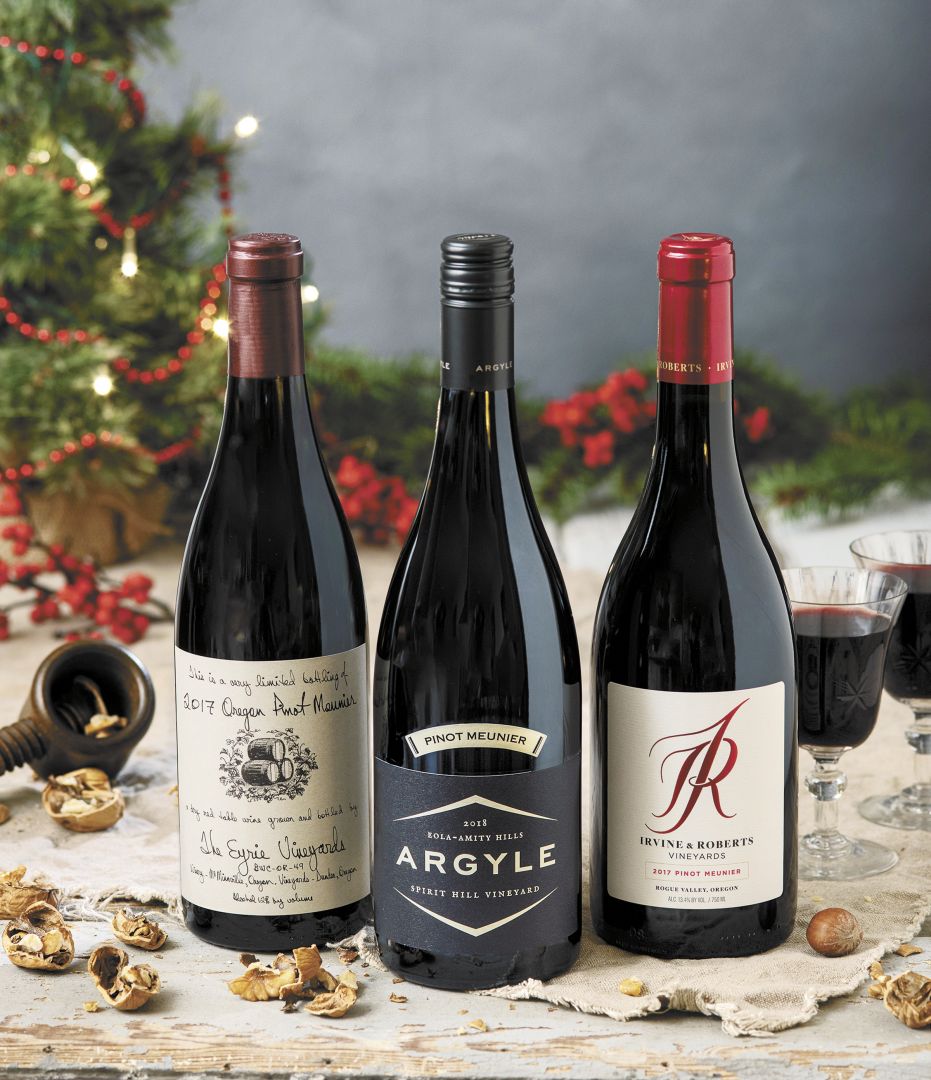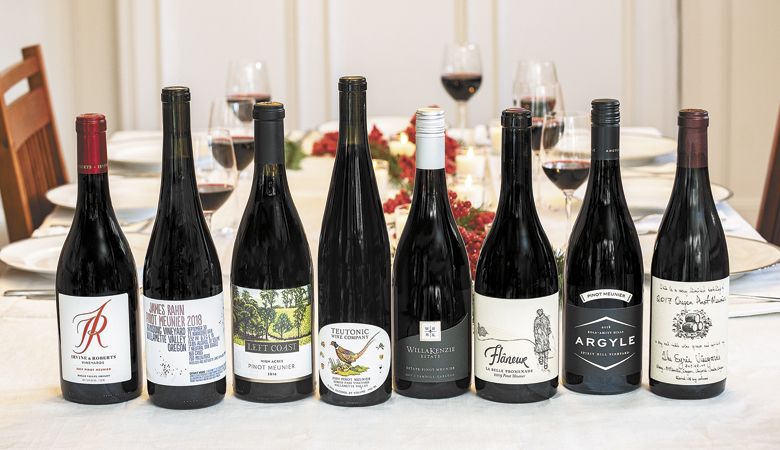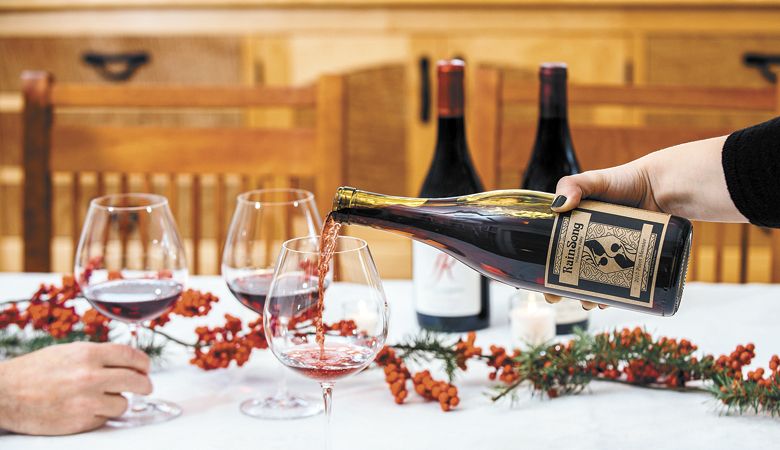Merry Meunier
Fruity red an unexpected, offbeat holiday delight
As households gather at the dinner table for what promises to be an unusual pandemic holiday, the meal demands a surprise, something different.
Pinot Meunier is one of the three varieties in the traditional Champagne trifecta — with Pinot Noir and Chardonnay — adding bright fruit and verve to the balance of flavors. Although it remains the backbone to some of the world’s most coveted and notable sparklers, it’s also a wine we hear very little about. On its own, Pinot Meunier is mostly uncommon in the Old World, but in Oregon, it’s proving a cult favorite.
Meunier means “miller” in French, referring to the flour-like dustiness often found on the leaves. It’s generally a high-acid, cool-climate grape, both light and fruity. These features are part of the reason it’s such a great addition to Champagne blends, but it’s also what it makes it so delicious as a single-varietal wine. Though somewhat maligned in France, perhaps because it’s a less than noble variety, Pinot Meunier is similar to its Pinot Noir relative, in that the finished wine is expressive of bright or candied red fruit with layers of dusty minerality and savory mushroom or soil notes. It’s often compared to Gamay, for its light, bright, approachable style; yet Pinot Meunier is purely its own: joyful, vivacious and intriguing.
Thankfully, Oregon is not the Old World. With no regulations on what and where to plant, wineries experiment more extensively with varieties and winemaking techniques. The Eyrie Vineyards’ David Lett was the first to plant Pinot Meunier in Oregon in 1965. Now, decades later, it finally seems to be catching on. As Oregon’s sparkling offerings continue to grow, some Oregon brands are producing Pinot Meunier with leftover juice, while others are finding reasons to intentionally plant and produce Pinot Meunier for its distinctive characteristics.

“We find that Pinot Meunier beautifully expresses the terroir of the Willamette Valley,” said Olga Tuttle, co-owner of Teutonic Wine Company in Portland. “It also pairs really nicely with certain foods. It’s a medium-bodied, extremely fruity red wine that is easily consumed on its own.”
Nate Klostermann, winemaker at Argyle Winery in Dundee, emphasizes the dynamic quality of Pinot Meunier: “It has both freshness and density in the structure, while the aromatics are both floral and savory. It’s a counterintuitive wine that has me excited to keep exploring as a single varietal bottling as both red wine and sparkling wine.”
With hundreds of Oregon Pinot Noir producers, making something unique can give brands an edge, a way to differentiate themselves in the market. Today’s consumers are better educated about wine than ever, seeking bottles that offer something new or even geeky.
Russell Lichtenthal, sales and hospitality manager of Flâneur Wines in Carlton, says, “It made sense that while we’re using Pinot Meunier for our sparkling program, we also realize people want to experiment. So, having something new to offer, a new point of conversation, keeps the American buyer really engaged; and the American buyer seems curious to find the next new thing. From our perspective, this is really good, really exciting and really positive. It’s nice to have a fan base that’s interested.”
Producers are also considering climate change and environmental factors. Winemaker James Rahn of James Rahn Wine Company, located outside Carlton, says, “I feel that Meunier will hold together pretty well with the warming climate. It seems to retain its acidity better than Pinot Noir.”
Tuttle also stresses the importance of elevation, “Like with all grape varieties that do better in cool-climate sites, it will be a challenge for established vineyards in areas that are already getting hotter. The best solution is to continue looking for higher elevations and cooler growing sites.”
Lichtenthal adds, “Our higher elevation site in the Chehalem Mountains adds to the lightness of the wine. If we were to grow this grape in a warmer site, one could expect it to be meatier, more savory and maybe [offer] just a richer expression. I think the tannins might be a little bit stronger and more fruit-forward. But I think that it would come at the sacrifice of the bright acidity.”
Marcus Hall, winemaker/co-owner of RainSong Vineyard based in Cheshire, acknowledges Pinot Meunier’s success at his site in Central Oregon. “Due to this grape having a slightly earlier ripening time, we can avoid some of the problems typically associated with colder and wetter weather that can move in later in the season, or migratory birds moving south sooner than normal and eating our crop,” he said. “In the past, we’d play a game of chicken with the weather and the birds, letting our fruit hang as long as possible to allow it to ripen. In the last 10 to 15 years though, climate change seems to have caused a dramatic difference in when the grapes are ready for harvest. I’d say our average picking date is about two weeks earlier than it used to be, which makes it easier to grow a ripe crop and harvest the majority of it before the birds and the weather takes their share.”
The 2020 vintage has been particularly challenging for Oregon vintners. The late-season wildfires took their toll on many local vineyards with some sacrificing production entirely. Flâneur has opted not to produce any red wines from 2020; the winery will be whole-cluster pressing all its red grapes into sparkling and rosés.
“We’re learning the hard way that Pinot Meunier, although not as much as Pinot Noir, is sensitive to smoke damage,” Hall noted. “What’s interesting is that our block of Pinot Meunier, grown adjacent to our Pinot Noir, had significantly less smoke damage. We can’t say if this is due to the nature of the grape, the relative ripeness at the time of the exposure or another factor, but we’re hopeful that as the industry adjusts to shifting norms, we’ll learn better mitigating techniques for fruit damaged by smoke exposure.”
As for food pairings, the general consensus among producers points to duck and foul, especially wild game like pheasant, wild turkey and chukar. Lichtenthal suggests, “This wine is fantastic with early autumnal fare. Almost anything that goes with Pinot Noir is going to do well with Pinot Meunier.” Roasted white meats like whole chicken, squab and quail are ideal. Erik Kramer, winemaker of WillaKenzie Estate in Yamhill, says, “As we get into the cooler weather of fall and early winter, I’m roasting more chicken in the oven and making heartier poultry dishes — as opposed to spending more time on the grill over the summer. As a stand-alone wine, Pinot Meunier is a great match for these richer types of poultry dishes.”
Rahn sums it all up very neatly, “I just like the soft, clean characteristics of Meunier. The fruit is light but vibrant, with red flavors and floral aromatics. It’s just really pretty.”
If that’s not reason enough to pick up a bottle, I don’t know what is.
Tasting Notes by Tamara Belgard
Irvine & Roberts 2017 Pinot Meunier, Rogue Valley
Distinctively Southern Oregon, it’s well-balanced with acidity, viscosity, structure and fully ripened flavors of blackberry, black plum and rosehips. (sold out)
James Rahn 2018 Rainsong Vineyard Pinot Meunier, Willamette Valley
With its bracing acidity, this is definitely a food wine. Unrelenting, like the derby skater on the label, this wine elbows you with explosive flavors of tart raspberries and freezer jam that combine with a welcome briny salinity. $35
Left Coast Estate 2016 High Acres Pinot Meunier, Willamette Valley
Luxuriously scented with floral notes reminiscent of Grandma’s vintage soap, the wine displays a backbone of bright red cherry and red currants, and slightly sanguine, like a thin streak of iron runs through it. $50
Teutonic 2019 Pinot Meunier, Willamette Valley
Light in color, almost like a rosé, the wine is classic in style with high acid and low alcohol. A bit austere with strawberry, floral and soapy qualities. It’s subtle and elegant, but at the same time, tickles your nose hairs and enlivens the senses. $34
WillaKenzie 2017 Pinot Meunier, Yamhill-Carlton
Aromatic notes of strawberry, cherry, rose and spice entice. On the palate, the wine tastes juicy and refined, offering a pure and transparent expression of the varietal. $38
Flâneur 2019 La Belle Promenade Pinot Meunier, Chehalem Mountains
Well balanced with candied red cherries, earthy notes and white flowers. This carbonic, Beaujolais-style wine shows a dusty minerality, a little green bell pepper and mouthwatering acidity like a good Meunier should. $32
Argyle 2018 Spirit Hill Vineyard Pinot Meunier
Deep, dark and dense, this wine puts on a dramatic display of elegant red fruit supported by delicate floral notes and savory undertones. (sold out)
The Eyrie Vineyards 2017 Pinot Meunier, Dundee Hills
This stunning wine shows immense depth. With entrancing aromas of cigar box, it’s rustic and beautifully balanced with dark raspberries, black cherries, mint and tobacco leaf. $45
RainSong 2017 Pinot Meunier, Willamette Valley
The kind of complexity you seek in a wine. Dusty cocoa on the nose with baker’s spice, raspberry cobbler, juicy plum, red currants and pomegranate seeds. Firm tannins lead to a tart fruit and herbaceous finish. $25











